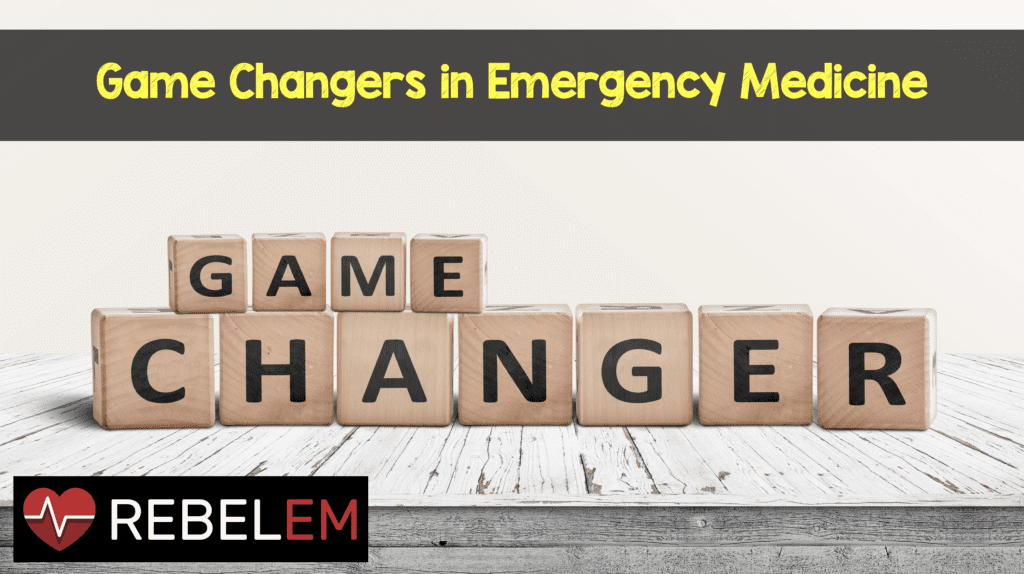
 Recently, I have been asked if there are any studies that have been performed over the past few years that should shape the way emergency medicine physicians should practice and can greatly improve patient care. So I asked some of my friends and colleagues if there are any studies that stick out in their minds. Below is a list of four game changers in emergency medicine that others felt were of importance.
Recently, I have been asked if there are any studies that have been performed over the past few years that should shape the way emergency medicine physicians should practice and can greatly improve patient care. So I asked some of my friends and colleagues if there are any studies that stick out in their minds. Below is a list of four game changers in emergency medicine that others felt were of importance.
The ADAPT Trial [1]:
Mentioned by Louise Cullen (@louisecullen)
-
 Study: Prospective observational
Study: Prospective observational - Total patients: 1,975
- What they did: Identified low risk patients (TIMI of 0, EKG w/o new ischemic changes, negative contemporary or sensitive troponin I at 0 & 2 hours) who could be safely d/c home
- Measured outcome: Major Adverse Cardiac Events (MACEs) at 30 days
-
What they found:
- 392 pts (20%) were low risk
- 1 of 392 pts (0.25%) had MACE
- Sens 99.7%; Spec 23.4%
- NPV 99.7%; PPV 19%
- Conclusion: 20% of patients could be discharged home after this accelerated diagnostic protocol (ADP) with 99.7% sens and 99.7% NPV for MACE.
My Thoughts on the Study
- TIMI risk score is used as an objective indicator of high, intermediate, and low risk patients. Angina is a subjective complaint. Clinical judgment is needed, and can be quite different amongst providers. The newest CP score in the works is called the EDACS score. It was first derived in an ED population and currently awaiting validation, which is occurring in Canadian, UK, and European populations at the present time
- In an indigent patient population, how do we guarantee 72 hour follow up? Do these patients need 72 hour follow up or 30 day follow up? George T et al found there were no MACEs by 30 days using the ADAPT protocol in his study
- What is an acceptable miss rate? 1%, 2%, etc? From a public health standpoint the acceptable miss rate is 2 – 5%, ED physicians want a 1% miss rate, but from a lawyers standpoint an acceptable miss rate is 0%.
Sensitivity of CT Performed Within 6 Hours of Onset of Headache for Diagnosis of SAH [2]:
Mentioned by Teresa Chan (@TChanMD)
-
 Study: Prospective cohort, pilot study in 11 tertiary care EDs across Canada
Study: Prospective cohort, pilot study in 11 tertiary care EDs across Canada - Total patients: 3,132
- What they did: Neurologically intact adults with acute headache peaking in intensity within one hour of onset had CT to rule out SAH within 6 hours of headache onset
- Measured outcome: SAH (Defined as SAH on CT, Xanthochromia in CSF, and/or Any RBCs in final tube of CSF) seen on cerebral angiography
-
What they found:
- 240 (7.7%) with confirmed SAH
- Overall (Sens 92.9%, Spec 100%, NPV 99.4%, PPV 100%)
- 953 pts had scan within 6 hours of headache onset (Sens 100%, Spec 100%, NPV 100%, and PPV 100%)
- All pts with SAH and scanned within 6 hours (121 patients) of headache onset were identified by head CT
- Conclusion: CT is extremely sensitive in identifying SAH when performed within 6 hours of headache onset
My Thoughts on the Study
-
As per my discussion with Teresa…
- This study is not yet externally validated: Based on a Canadian cohort
- Third generation (64 slice) CT scanners were used: Not validated with 1st and 2nd generation scanners
- CTs were read by staff neuroradiologists: If working in a facility that does not have 24-7 staff neuroradiology reading the scans, is the read of a resident radiologist equivalent?
- Currently, there is an absence of a single accepted standard criterion for SAH: There is some controversy in the optimal method of detecting SAH
Antiemetic Treatment for Acute Gastroenteritis in Children [3]:
Mentioned by Ken Milne (@TheSGEM) from The Skeptics Guide to Emergency Medicine
-
 Study: Systematic Cochrane Review
Study: Systematic Cochrane Review - Total patients: 10 trials with 1479 patients
- What they did: Provided consistent and robust evidence through a systematic review to support the use of antiemetics for children presenting with vomiting associated with acute gastroenteritis in primary and secondary care.
-
Measured outcomes:
- Time to cessation of vomiting after antiemetics
- Parental satisfaction
- Cessation of vomiting
- Resumption of oral rehydration
- Hospitalization during ED stay and up to 72 hours following discharge
-
What they found: Ondansetron (oral or IV) vs placebo
- Increased cessation of vomiting RR 1.44
- Reduced hospital admission rate RR 0.40
- Reduced need for IV rehydration therapy RR 0.41
- No difference noted in return visits to the ED
- Conclusion: There is clear evidence that ondansetron is the best treatment to allow oral rehydration therapy in children with acute gastroenteritis
My Thoughts on the Study
- The NNT for cessation of vomiting was 5 and the NNT for no IV rehydration therapy was 6
- The studies included were noted to be low – mid grade quality studies
- A majority of these studies focused on clinician focused, rather than patient/parent focused outcomes
- There is some evidence that there is an association between ondansetron and an increased incidence of diarrhea, but further studies are needed
Targeted Temperature Management at 33°C versus 36°C after Cardiac Arrest [4]:
Mentioned by Anand Swaminathan (@EMSwami) from EM Lyceum
-
 Study: Multicenter, Randomized Control Trial in 36 ICUs in Europe and Australia
Study: Multicenter, Randomized Control Trial in 36 ICUs in Europe and Australia - Total patients: 950 unconscious adults after OHCA
- What they did: Compare two target temperatures (33º vs 36º C) for therapeutic hypothermia in OHCA
-
Measured outcome:
- All-cause mortality
- Composite of poor neurologic function or death at 180 days (Cerebral Performance Category and Modified Rankin Scale)
- What they found:
- 50% mortality in 33°C group vs 48% in the 36°C group
- At 180 day follow-up, 54% mortality in the 33°C group had died or had poor neurologic function vs 52% of patients in the 36°C group
- Conclusion: In unconscious survivors of OHCA of presumed cardiac cause, therapeutic hypothermia at a targeted temperature of 33°C was no better than a targeted temperature of 36°C
My Thoughts on the Study
- There was no harm with a targeted temperature of 33°C vs 36°C: Therapeutic hypothermia influences all organ systems, not just the brain and any potential benefit should be balanced against possible side effects
- The recommended temp of 32° to 34°C has derived from experiments in animals and similar results have been observed with milder cooling of 33º to 35º C
- This trial was not blinded to target temperature used which could lead to some bias of results
- Ken Milne over at The SGEM also had a great post and podcast on this
- Scott Weingart also has a great post and podcast on this as well
- There was also a trial published in JAMA Nov 2013: Its conclusion stated prehospital therapeutic hypothermia reduced core temperature by hospital arrival and time to reach a temp of 34ºC, but did not improve survival or neurological outcomes in patients with OHCA. Also more patients in the cooling arm re-arrested which gave a NNH of 20.
- Finally, there may be a select group that would benefit from therapeutic hypothermia, but for now a “scoop and run” approach with no therapeutic hypothermia seems to be the best evidence.
Take Home Points
- The ADAPT Trial: Patients with an ECG without ischemic changes, TIMI score of 0, and Negative sensitive Tn I at 0 and 2 hours = safe for discharge and follow up as outpatient within 30 days
- CT Performed Within 6 Hours of Onset of Headache in the Diagnosis of SAH: 3rd generation or newer CT scanners are extremely sensitive in identifying SAH when performed within 6 hours of headache onset and read by staff neuroradiologists, but would like to see more validation studies.
- Antiemetics in Acute Gastroetnertitis: Ondansetron is the best treatment to allow oral rehydration therapy in children with acute gastroenteritis
- Targeted Therapeutic Hypothermia: There may be a select group that would benefit from therapeutic hypothermia, but for now a “scoop and run” approach with no therapeutic hypothermia in the prehospital setting seems to be the best evidence
References:
- Than M et al. 2-Hour Accelerated Diagnostic Protocol to Assess Patients with Chest Pain Symptoms Using contemporary Troponins as the Only Biomarker: the ADAPT Trial. JACC 2012. PMID: 22578923
- Perry JJ et al. Sensitivity of Computed Tomography Performed Within Six Hours of Onset of Headache for Diagnosis of Subarachnoid Hemorrhage: Prospective Cohort Study. BMJ 2011. PMID: 21768192
- Carter B et al. Antiemetic Treatment for Acute Gastroenteritis in Children: An Updated Cochrane Systematic Review with Meta-Analysis and Mixed Treatment Comparison in a Bayesian Framework. BMJ Open 2012. PMID: 22815462
- Nielsen N et al. Targeted Temperature mangement at 33C Versus 36C After Cardiac Arrest. NEJM 2013. PMID: 24237006
The post Game Changers in Emergency Medicine appeared first on REBEL EM - Emergency Medicine Blog.
